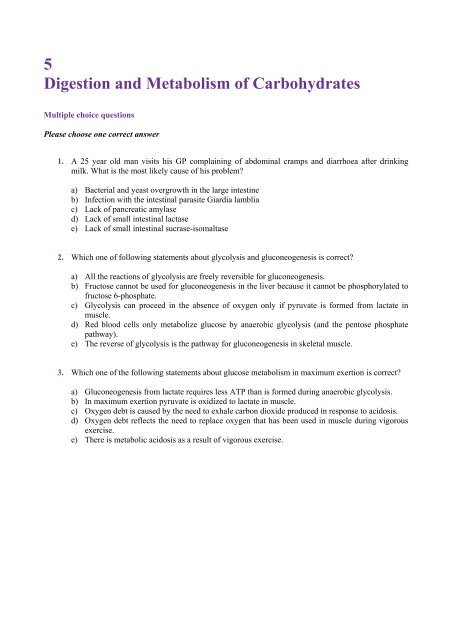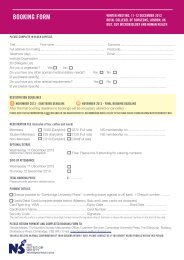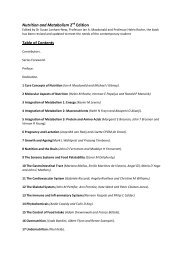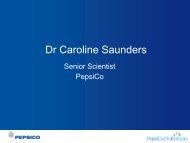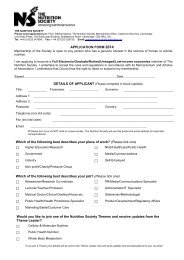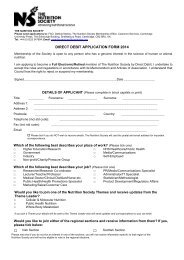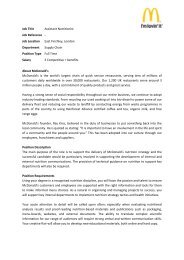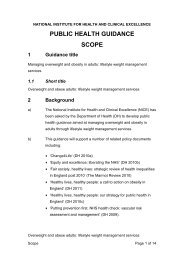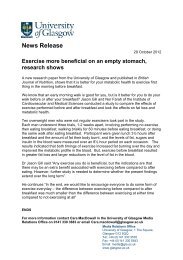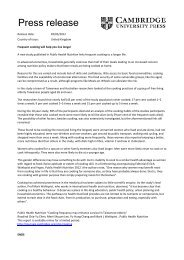Chapter 5 - The Nutrition Society
Chapter 5 - The Nutrition Society
Chapter 5 - The Nutrition Society
You also want an ePaper? Increase the reach of your titles
YUMPU automatically turns print PDFs into web optimized ePapers that Google loves.
5<br />
Digestion and Metabolism of Carbohydrates<br />
Multiple choice questions<br />
Please choose one correct answer<br />
1. A 25 year old man visits his GP complaining of abdominal cramps and diarrhoea after drinking<br />
milk. What is the most likely cause of his problem?<br />
a) Bacterial and yeast overgrowth in the large intestine<br />
b) Infection with the intestinal parasite Giardia lamblia<br />
c) Lack of pancreatic amylase<br />
d) Lack of small intestinal lactase<br />
e) Lack of small intestinal sucrase-isomaltase<br />
2. Which one of following statements about glycolysis and gluconeogenesis is correct?<br />
a) All the reactions of glycolysis are freely reversible for gluconeogenesis.<br />
b) Fructose cannot be used for gluconeogenesis in the liver because it cannot be phosphorylated to<br />
fructose 6-phosphate.<br />
c) Glycolysis can proceed in the absence of oxygen only if pyruvate is formed from lactate in<br />
muscle.<br />
d) Red blood cells only metabolize glucose by anaerobic glycolysis (and the pentose phosphate<br />
pathway).<br />
e) <strong>The</strong> reverse of glycolysis is the pathway for gluconeogenesis in skeletal muscle.<br />
3. Which one of the following statements about glucose metabolism in maximum exertion is correct?<br />
a) Gluconeogenesis from lactate requires less ATP than is formed during anaerobic glycolysis.<br />
b) In maximum exertion pyruvate is oxidized to lactate in muscle.<br />
c) Oxygen debt is caused by the need to exhale carbon dioxide produced in response to acidosis.<br />
d) Oxygen debt reflects the need to replace oxygen that has been used in muscle during vigorous<br />
exercise.<br />
e) <strong>The</strong>re is metabolic acidosis as a result of vigorous exercise.
CH 3<br />
CH 3<br />
C<br />
O<br />
C<br />
O<br />
COOH<br />
pyruvate<br />
SCoA<br />
acetyl CoA<br />
enzyme-bound<br />
thiamin diphosphate<br />
CoASH<br />
CO 2<br />
CH 3<br />
CHOH<br />
CH 3<br />
C O<br />
thiamin diphosphate<br />
hydroxethyl thiamin diphosphate<br />
S<br />
SH<br />
S<br />
S<br />
acetyl lipoamide<br />
SH<br />
SH<br />
lipoamide<br />
NADH<br />
NAD +<br />
reduced<br />
lipoamide<br />
4. <strong>The</strong> above diagram shows the reaction of the pyruvate dehydrogenase multienzyme complex.<br />
Which one of following statements is correct?<br />
a) In thiamin (vitamin B 1 ) deficiency pyruvate formed in muscle cannot be transaminated to<br />
alanine.<br />
b) In thiamin (vitamin B 1 ) deficiency pyruvate formed in muscle cannot be carboxylated to<br />
oxaloacetate.<br />
c) <strong>The</strong> reaction of pyruvate dehydrogenase involves decarboxylation and oxidation of pyruvate,<br />
then formation of acetyl CoA.<br />
d) <strong>The</strong> reaction of pyruvate dehydrogenase is readily reversible, so that acetyl CoA can be used for<br />
the synthesis of pyruvate, and hence glucose.<br />
e) <strong>The</strong> reaction of pyruvate dehydrogenase leads to the oxidation of NADH to NAD + , and hence<br />
the formation of ~2.5 x ATP per mol of pyruvate oxidized.<br />
5. Which one of following statements about favism (lack of glucose 6-phosphate dehydrogenase) and<br />
the pentose phosphate pathway is correct?<br />
a) In favism red blood cells are more susceptible to oxidative stress because of a lack of NADPH<br />
for fatty acid synthesis.<br />
b) People who lack glucose 6-phosphate dehydrogenase cannot synthesize fatty acids because of a<br />
lack of NADPH in liver and adipose tissue.<br />
c) <strong>The</strong> pentose phosphate pathway is especially important in tissues that are synthesizing fatty<br />
acids.<br />
d) <strong>The</strong> pentose phosphate pathway is the only source of NADPH for fatty acid synthesis.<br />
e) <strong>The</strong> pentose phosphate pathway provides an alternative to glycolysis only in the fasting state.
6. Which one of following statements about glycogen synthesis and utilisation is correct?<br />
a) Glycogen is synthesized in the liver in the fed state, and then exported to other tissues in low<br />
density lipoproteins.<br />
b) Glycogen reserves in liver and muscle will meet energy requirements for several days in<br />
prolonged fasting.<br />
c) Liver synthesizes more glycogen when the hepatic portal blood concentration of glucose is high<br />
because of the activity of glucokinase in the liver.<br />
d) Muscle synthesizes glycogen in the fed state because glycogen phosphorylase is activated in<br />
response to insulin.<br />
e) <strong>The</strong> plasma concentration of glycogen increases in the fed state.<br />
7. Which one of following statements about glycogen metabolism is correct?<br />
a) Glycogen synthase activity is increased by glucagon.<br />
b) Glycogen phosphorylase is an enzyme that can be activated by phosphorylation of its own serine<br />
residues.<br />
c) Glycogen phosphorylase cannot be activated by calcium ions.<br />
d) cAMP activates glycogen synthesis.<br />
e) Glycogen phosphorylase breaks the α1-4 glycosidic bonds by hydrolysis.<br />
8. In glycolysis, the conversion of 1 mol of fructose 1,6-bisphosphate to 2 mol of pyruvate results in<br />
the formation of:<br />
a) 1 mol NAD + and 2 mol of ATP<br />
b) 1 mol NADH and 1 mol of ATP<br />
c) 2 mol NAD + and 4 mol of ATP<br />
d) 2 mol NADH and 2 mol of ATP<br />
e) 2 mol NADH and 4 mol of ATP<br />
<strong>The</strong> <strong>Nutrition</strong> <strong>Society</strong> Textbook Series, Introduction to Human <strong>Nutrition</strong>, Second Edition<br />
© 2009, 2002 by <strong>The</strong> <strong>Nutrition</strong> <strong>Society</strong>.
Answers<br />
1. D.<br />
2. D.<br />
3. E.<br />
4. C.<br />
5. C.<br />
6. C.<br />
7. B.<br />
8. E.


